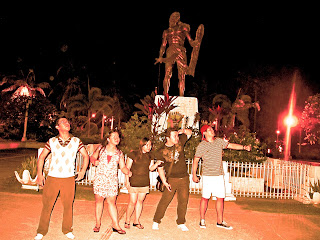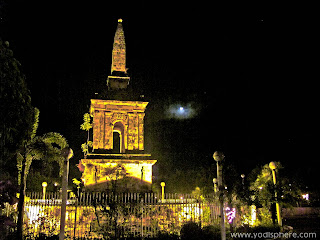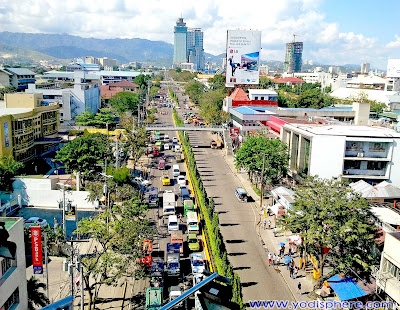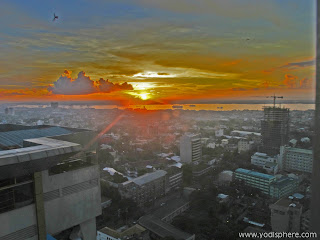“Sail away, sail away, sail away...
From Bissau to Pilau - in the shade of Avalon,
From Fiji to Tiree and the Isles of Ebony,
From Peru to Cebu, feel the power of Babylon”
[Orinoco Flow] – Enya
Aside from dried mangoes, it was actually the song Orinoco Flow by Enya that got me curious about Cebu. I got this dreamy idea that maybe there is really some Celtic mystery on this part of the Philippines that it is worth mentioning together with other powerful places like the Isles of Ebony, Fiji, Tiree and Babylon.
In many ways and based on my prior inquiries, Cebu is an idyllic place, rich in history and home to the Philippine Musae, the goddesses of music and voice. However, to be honest, a week before flying to Cebu, I was feeling a bit tired and jaded about traveling to another city. When you’re going to another place, with same scene, same noise, same scent, the spark of newness fades and travel can feel like a worthless, pointless drag, just a continuation of bullshit on different archipelago.
Nevertheless, this is a sponsored business trip, a proctoring gig for MSAP 2011
Nevertheless, this is a sponsored business trip, a proctoring gig for MSAP 2011
so there’s no point on expecting grandeur and pleasure. I just go – it’s my first time to visit Cebu anyway and it’s an all expenses paid trip, so why complain. I consider this trip to be more than the seeing of sights; it is an opportunity for me to take a quick peek at the famous Queen City of the South.
The Queen’s Past
Before the arrival of the Spaniards in the 16th century, Cebu then known as Zubu (or Sugbo) was an island inhabited by pagan, and islamic people who traded with other Asian civilizations.
It was the first Spanish settlement created in the Philippines. Ferdinand Magellan, a Portuguese explorer, found Cebu in April of 1521, but failed to claim the island after he was killed twenty days later.
 | |
| Lapu-lapu soldiers waiting for Magellan army's revenge --- Here on 27 April 1521, Lapu-lapu and his men repulsed the Spanish invaders killing their leader Ferdinand Magellan. Thus, Lapu-lapu became the first Filipino to have repelled European aggression |
 | |
| "On this spot, Ferdinand Magellan died on April 27, 1521. Wounded in an encounter with the soldiers of Lapu lapu, Chief of Mactan Island. One of Magellan's ships, the Victoria under the command of Juan Sebastian El cano sailed from Cebu on May 1, 1521 and anchored at San Lucar de Barramedaon September 6, 1522, thus completing the first circumnavigation of the Earth" - 1941 Text from the site historical marker |
There are lots of monuments and markers of Spain and Catholicism in Cebu. These sites are often visited and the many stories of Magellan and Lapu Lapu are passed on to new curious generations. Too bad we didn’t got the chance to visit the famous Magellan’s Cross due to our mixed-up schedule.
Cebu City is Manila minus the mayhem
Cebu has always been a major population center, primarily due to its key location astride the achipelago’s main trade routes. It serves as the hub around which the Visayas revolves and has profited greatly from this favorable location, thus attracting migrants from all over the Visayas and Mindanao region.
Based on my quick assessment and observation of the City, Cebu is Metro Manila minus the mayhem. There is road traffic and, yes it is also chaotic but it is not insane. Cebu City’s size and layout is a little organized and can be understood rather than endured.
I can also generally conclude, from the four taxi rides I took, that hardly any taxi drivers in Cebu metropolis are employed by Satan. They will not ask you for “dagdag” (additional fare) unlike in Metro Manila. Cebu City has achieved the metropolis status without coming to resemble the final circle of hell. I just hope it stayed that way.
When we tried a short walk at downtown Colon around midnight for snack, I felt like the place is very similar to Recto Street in Quiapo. There are lots of hookers, bugaw, beggars sleeping on sidewalks and other elements of city decay. Still, the safest city I’ve been is Davao.
I keep on noticing this videoke like stations everywhere we go, at schools, along sidewalks, sari-sari stores and other public areas. I later learned that these are coin operated water drinking stations distributed across the city. Really convenient and cool business I must say. But we haven't tried drinking from it.
It is interesting to note the difference between uptown and downtown Cebu. I gather from our small chitchat with our host that uptown Cebu around Fuente Osmeña is the place where the rich Cebuanos and Tsinoys reside. They said it’s like the Beverly Hills of Cebu. On the other hand, downtown Cebu (where we are billeted) have such completely opposite character which seems like it’s a different city. Downtown along Colon Street is older, dirtier, more impoverished and more vice strewn than uptown.
 |
| View of Osmeña Street from GV Tower Hotel |
Based on my quick assessment and observation of the City, Cebu is Metro Manila minus the mayhem. There is road traffic and, yes it is also chaotic but it is not insane. Cebu City’s size and layout is a little organized and can be understood rather than endured.
 |
| Colon - Osmeña Intersection - Cebu City Downtown |
Cebuanos strictly follow pedestrian rules. I remember an incident while crossing Colon Street and Osmeña Intersection where Aldan and me hurriedly crossed the street even when the pedestrian green light signal was off. We are surprised because nobody from the crowd is crossing the street even if there are no vehicles passing – only the two of us did (just like in Manila) and they are staring at us probably saying “Manileños, pisting yawa!”
 |
| Downtown Cebu afternoon skyline |
 |
| Yodz afternoon emo shot |
I can also generally conclude, from the four taxi rides I took, that hardly any taxi drivers in Cebu metropolis are employed by Satan. They will not ask you for “dagdag” (additional fare) unlike in Metro Manila. Cebu City has achieved the metropolis status without coming to resemble the final circle of hell. I just hope it stayed that way.
The City’s dark side
Although Cebu City, the Queen City of the South, boasts of famed Cebuano hospitality and faith, economic activity, competitive administration and renowned scenic spots, don’t get your hopes up. With apologies to the few western foreigners and the like, if I were to draw a portrait of the average foreigner here, it would be of a divorced middle-aged man on shorts with unkempt hair, probably on drugs with a much younger brown-skinned Filipina on his arm. Familiar eh?
 |
| Cebu City downtown at dawn |
When we tried a short walk at downtown Colon around midnight for snack, I felt like the place is very similar to Recto Street in Quiapo. There are lots of hookers, bugaw, beggars sleeping on sidewalks and other elements of city decay. Still, the safest city I’ve been is Davao.
 | |
| Coin operated drinking stations |
It is interesting to note the difference between uptown and downtown Cebu. I gather from our small chitchat with our host that uptown Cebu around Fuente Osmeña is the place where the rich Cebuanos and Tsinoys reside. They said it’s like the Beverly Hills of Cebu. On the other hand, downtown Cebu (where we are billeted) have such completely opposite character which seems like it’s a different city. Downtown along Colon Street is older, dirtier, more impoverished and more vice strewn than uptown.
Cebu City isn’t Metro Manila, but that doesn’t make it a place I’d want to be spending out my holiday – with exception to the Sinulog festival of course.
P.S.
More of our Cebu Trip on my upcoming posts. I'll be featuring our food escapades, GV Tower Hotel not-so-good experience, our visit to the Cebu Cathedral and camwhoring at the Top - Busay Hills and the best part of our trip, our visit to Bantayan Island.
More of our Cebu Trip on my upcoming posts. I'll be featuring our food escapades, GV Tower Hotel not-so-good experience, our visit to the Cebu Cathedral and camwhoring at the Top - Busay Hills and the best part of our trip, our visit to Bantayan Island.
________________
Header Image Source: "Queen of Temptation" digital art by Durango

No comments:
Post a Comment